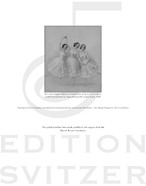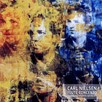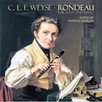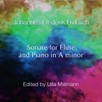
Sonata in B major opus 1
Composer: Johan Peter Hartmann
Instrument: Flute and Piano
Level: Advanced
Published: 2010
Price: €28.00
Item details
-
Description +
-
Duration: 27 min.
J.P.E. Hartmann (Johan Peter Emilius) was born on May 14th 1805. He comes from a family of German musicians. His grandfather Johann Hartmann immigrated to Denmark and as a violinist and composer had a great impact on the music environment in Copenhagen. His father A.W. Hartmann was an organist at Garnisons Church in Copenhagen, a position later taken over by his son. J.P.E. Hartmann lived an exceptionally long and rich life, and his music was among the cornerstones in The Danish Golden Age. Today he is remembered especially for his operas (Raven and the Little Kirsten), his symphonies and also his music to Oehlenschlägers National epos “Guldhornen” (1832). The manuscript for J.P.E Hartmann’s Flute Sonata in B major, opus 1 is dated June 3rd 1825, but is actually composed after his piano quartet, opus 2 (1823) and his Concert overture, opus 3 (May 1825).
The Flute Sonata in B major, opus 1, was written for the cultural elite gathered around the wine merchant Waagepetersen. Here you could hear Beethoven’s string quartets and music from Spohr and Weber, among others, and especially Friedrich Kuhlau who in the years from 1825 made his mark on the chamber music evenings at patrons of art or literature. Kuhlau wrote no less than 60 works, where one or more flutes perform the concerto either as a flute ensemble (2, 3, 4 flutes), with strings (quintets, opus 51, 1-3) or with piano (for example 10 flute sonatas). The blind organist Niels Peter Jensen (1802-46), one of Kuhlaus’ students, who also played flute – even as a virtuoso (as opposed to Kuhlau who played piano), was Hartmann’s teacher in instrumentation. Hartmann’s Flute sonatas are written for N. P. Jensen. The sonata is in four large-scale movements, whose style shows reminiscences from Kuhlau, but also shows the harmonic richness and melodic creativity with which Hartmann could already create a personal expression in his instrumental works.
The Danish Golden Age (~1810-1850) can be defined as a cultural high point that was dominated by a series of outstanding authors (Oehlenschläger, H. C. Andersen, Baggesen, Kirkegaard, Heiberg) a group of painters (Eckersberg, Lundbye, Skovgaard, Købke) whose works have found their way to the international art world, as well as composers such as C. E. F. Weyse, J. P. E. Hartmann, Friedrich Kuhlau and (although a bit late for the Golden Age) N.W. Gade.
Of the music originally composed for flute in The Danish Golden Age, Friedrich Kuhlau’s enormous collection of works should be emphasized. Weyse composed a single work for flute and piano, Andante et Rondeau (Edition SVITZER). Niels Peter Jensen wrote a long series of works for flute, among them a concerto in a-minor with full orchestra (Edition Eulenburg), numerous sonatas with piano, duos for two flutes and solo fantasies. We should also mention Johannes Frederik Frøhlich (1806-60), also a student of Kuhlau who at that time was a known and often used composer for The Royal Theatre’s ballets. We are aware of two flute sonatas that he wrote, a Duo Concertante for two flutes, a Quartet for four flutes, and a Divertissement with Symphony Orchestra.
J.P.E. Hartmanns B major sonata, opus 1, places itself centrally as a treasure of The Danish Golden Age. The sonata has through numerous CD-recordings and as the required piece at the Carl Nielsen International Music Competition in Odense, proven its musical value.
Toke Lund Christiansen
April 2009
-
-
Instrumentation +
-
Flute and Piano
-
-
About the composer +
-
Hartmann was born and died in Copenhagen and came from a musical family of German descent. Although he received his music lessons initially from his father, he taught himself as much as possible. He complied with his father's wishes for him to study jurisprudence and consequently worked as a civil servant from 1829 to 1870, but also pursued an extensive musical career. By 1824, he was already the organist at the Garnisons Kirke in Copenhagen, and in 1832, he made his debut as a composer with the opera Ravnen (The Raven).
In 1836, he made his first study tour to Germany and France, where he made the acquaintance of such significant musical figures as Frédéric Chopin, Gioachino Rossini, Luigi Cherubini, and Louis Spohr. Spohr and the Danish composer Christoph Ernst Friedrich Weyse were Hartmann's most important mentors. Further journeys to Germany followed in the next few years, during which he also founded the Danish Musical Association in 1836, remaining its chairman until the end of his life. In 1843, he transferred from the Garnisons Kirke to play the organ for the Vor Frue Kirke, and became the director of the Student Choral Association. He also held both these posts until his death.
In 1867, after having taught at the Conservatory of Giuseppe Siboni since 1827, Hartmann helped co-establish and direct the Copenhagen Conservatory with Niels Gade and Holger Simon Paulli. He was the director of the Copenhagen Musical Society briefly in 1890 following the death of Gade. During his lifetime, Hartmann occupied a central place in Danish musical life and was considered by many to be an absolute authority on musical matters.
One of his sons, Emil Hartmann, also became a composer, while Carl Christian Ernst Hartmann became a sculptor. Niels Gade and August Winding both married daughters of J. P. E. Hartmann.
Lars von Trier, the film director, is the biological son of Fritz Michael Hartmann, the grandson of Emil Hartmann.
-
-
Credits +
-
Front Cover
The cousins Sophie, Juliette and Amalie Price in Pas des trois cousines,
a ballet divertissement by August Bournonville. Casino Teatret, 1848.Painting by Edvard Lehmann reproduced with kind permission by Teatermuseet I Hofteatret - The Theatre Museum in The Court Theatre
Thanks
This publication has been made possible by the support from the
Danish Weyse Foundation
Credits
Front Cover graphics and layout: Ronni Kot Wenzell
Painting: Edvard Lehmann (Pas des trois cousines)
English Translation: Janice Bogorad
Foreword: Toke Lund Christiansen
Printed in Copenhagen, Denmark
Copyright © Edition SVITZER
www.editionsvitzer.com
www.weyse.dk
-



